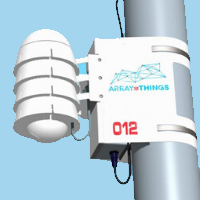| Carbon Monoxide |
Air Quality/Health |
SPEC Sensors 3SP-CO-1000 |
1 |
| Hydrogen Sulphide |
Air Quality/Health |
SPEC Sensors IAQ-100 |
1 |
| Nitrogen Dioxide |
Air Quality/Health |
SPEC Sensors 3SP-NO2-20 |
1 |
| Ozone |
Air Quality/Health |
SPEC Sensors 3SP-O3-20 |
1 |
| Sulfur Dioxide |
Air Quality/Health |
SPEC Sensors 3SP-H2S-50 |
1 |
| Air Particles |
Air Quality/Health (PM 2.5 to ~40) |
Alphasense OPC-N2 (included in ~20% of 2018 nodes); Plantower PMS7003 (all 2019 nodes) |
1 |
| Barometric Pressure |
Weather Conditions |
Bosch BMP180 |
1 |
| Humidity |
Weather Conditions |
Honeywell HIH4030, Honeywell HIH6130, Measurement Specialties HTU21D, Sensirion SHT25 |
1 |
| Temperature |
Weather Conditions |
Honeywell HIH6130, Measurement Specialties HTU21D, STMicroelectronics LPS25H, U.S. Sensor PR103J2, Sensirion SHT25, Bosch Sensortec BMP180, Measurement Specialties TSYS01, Texas Instruments TMP112 & TMP421 |
1 |
| Physical Shock/Vibration |
Detect heavy vehicles, shock to street pole (e.g. accident) |
Freescale Semiconductor MMA8452Q |
1 |
| Acceleration and Orientaion |
|
Bosch BMI160 |
1 |
| Magnetic Field |
Detect heavy vehicle flow |
Honeywell HMC5883L |
1 |
| Infrared Light |
Cloud cover, sunlight intensity |
AMS-TAOS USA TSL206RD |
1 |
| Light |
Cloud cover, sunlight intensity |
LAPIS Semiconductor ML8511, Melexis MLX75305 |
1 |
| Ultraviolet Intensity |
Cloud cover, sunlight intensity |
Silicon Labs Si1145 |
1 |
| Visible Light |
Cloud cover, sunlight intensity |
AMS-TAOS USA TSL250RD, Avago Technologies APDS-9006-020 |
1 |
| RMS Sound Level |
Sound intensity (loudness) |
Knowles SPV1840LR5H-B |
2 |
| Camera |
Street conditions, traffic flow, events |
ELP-USB500W02M-L 170, ELP-USB500W02M-L 140 |
2, 3 |
